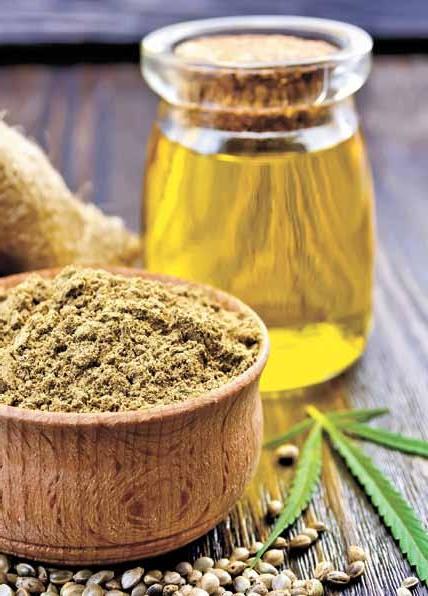
3 minute read
green living
kostrez/AdobeStock.com
Hemp-Derived Cannabidiol
Advertisement
A Primer on the Latest Research
by Sandra Yeyati
Ever since the Farm Bill of 2018 legalized the commercial production of hemp, U.S. sales of cannabidiol (CBD) have exploded onto the scene with hundreds, perhaps thousands, of vendors popping up around the country. CBD, a cannabinoid, is abundant in the hemp flower. “By law, hemp is defined as a variety of cannabis plant that has less than 0.3 percent THC, the psychoactive cannabinoid that induces a high,” says Shannon Livingston, a cannabis consultant for Florida Gulf Coast University, in Fort Myers.
Proven Benefits of CBD:
“The enthusiasm for CBD is soaring above the actual scientific evidence,” says Peter Grinspoon, M.D., a leading medical cannabis expert and primary care physician at Massachusetts General Hospital. “What’s known is that it helps with childhood epilepsy, and the U.S. Food and Drug Administration has approved a CBD drug for that. It is believed, and there’s good animal data and some human data to suggest, that CBD helps with chronic pain, insomnia and anxiety.”

Anxiety Under Study:
A clinical trial examining a high-CBD, low-THC (the psychoactive component) sublingual custom formulation for patients with moderate to severe anxiety is being conducted by Staci Gruber, Ph.D., director of Marijuana Investigations for Neuroscientific Discovery at McLean Hospital, in Belmont, Massachusetts, and associate professor of psychiatry at Harvard Medical School. “In the open label phase of this study, we’ve seen a rather dramatic and precipitous drop in symptoms of anxiety and depression after four weeks of treatment. We’ll see if this holds in the doubleblind phase, which is underway now,” she explains.
Entourage Effect:
Gruber notes that this customized formulation is a full-spectrum, whole-plant formula, saying, “You often seem to get a bigger bang for the buck using a full-spectrum or broad-spectrum (whole plant minus THC) product, rather than just a single extracted compound.” The process she’s describing is called the entourage effect—an assumption that all elements of the cannabis plant, working together, are most effective. “I believe there’s a significant role for terpenoids, flavonoids and other cannabinoid constituents of the plant, in addition to the big two (THC and CBD), and I have a grant to look at that very question,” she says.
How to Start CBD:
Experts agree that the best approach is to start low and go slow. “With experimentation, the patient will know what works for them,” Grinspoon says. “When CBD doesn’t work with my patients, the next step is to add a little bit of medical cannabis; it often takes a very little dose to help them with their sleep or their chronic pain.” Medical marijuana has been legalized in 36 states and the District of Columbia.
Route of Administration:
“When you smoke or vape, it’s an almost immediate onset, which is helpful for breakthrough pain, nausea and anything you want to treat immediately, but the effect is very short-lived,” Livingston explains. “For chronic pain, you might take a capsule or the patch that will last six to eight hours. If you want to fall asleep, a sublingual will work. For a skin condition, you might rub an oil on your skin. It’s really about the time of onset, how long you need it to last and what you’re treating.”
Ensuring Quality Control:
“Choose CBD providers that are certified for good manufacturing practices; conduct batch-specific, third-party testing on all of their products; and provide certificates of analysis directly from those labs. These tests can detect the presence of heavy metals, bacterial or microbial life, mycotoxins and pesticides, and also provide cannabinoid potency and terpene profiles,” says Grace Kaucic, senior communications and content manager at Bluebird Botanicals, a CBD company in Louisville, Colorado.
Our Built-In Cannabinoids:
In the mid-1990s, researchers discovered the endocannabinoid system of receptors and neurotransmitters throughout the body, which uses cannabinoids that our own bodies produce. “This system is believed to control homeostasis, the body’s ability to regulate itself and maintain normal functioning,” Grinspoon says, adding that he believes this system will become central to medicine over the next few years as more research is conducted.
Research is Ongoing:
“It’s an incredibly exciting time for cannabis science,” Gruber says. “There’s every reason to be optimistic about the potential of harnessing and exploiting the benefits of cannabis and cannabinoids in ways that may still surprise us, but to be cautiously optimistic. It is not a panacea. It will never be one-size-fits-all.”
Sandra Yeyati, J.D., is a professional writer. Reach her at SandraYeyati@gmail.com.








